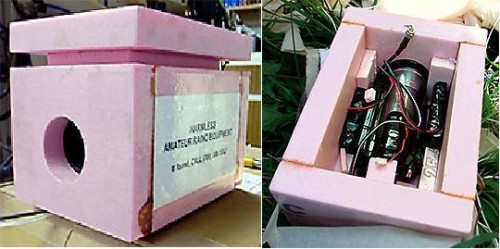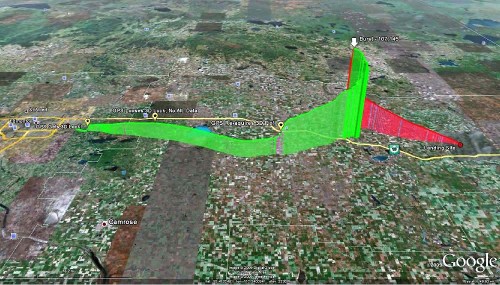Sending a balloon into near space has been done quite a few times by the BEAR group in Alberta Canada. Have a look at the details of their 4th launch where Tomoya Kamiko from Japan came to Canada with his HD camera to take it into space!
"The balloon and camera were launched at 7:44 AM, the balloon burst at 10:51 AM at 107,145 ft. and the camera landed via parachute at 11:40 AM, 89 miles from the launch site after a 3 hr. & 56 min. flight. At 5:45 the camera is nearing 107,145 ft. where there’s basically no air to conduct sound so nothing is heard other then what vibrations are conducted through the supporting cords, Styrofoam box and camera body to the camera microphone, like the bursting of the balloon at 6:26. Some of the balloon remains can be seen falling past the lens at 6:27 and then the fun begins as the Styrofoam box with the camera inside is repeatedly struck by the antenna hanging below it and several pounds of latex remaining from the burst balloon as everything tumbles every which way back to earth in the near vacuum at up to 7900 ft./min (90 mph) until there’s enough atmosphere for the parachute to start functioning."



Permalink
coooool but i have a question don’t you need special permission from air traffic control tower to lunch something similar?
Permalink
and love to if they would share with us the raw hd video data.
Permalink
Glad you liked the video, I just heard that it was covered on this site.
To answer your first question, yes and no, you don’t need permission to prepare and launch this type of flight, but you do need to file a NOTAM (Notice to all Airmen) to inform them of the flight, its specifics and get final launch clearance. Its a fairly simple procedure for smaller packages, once you hit certain sizes however it becomes much more involved.
Secondly the entire flights raw HD video was 32GB in size which can’t easily be made available online (hosting costs would kill me), it was cut down (removal of time when the lens frosted over etc…) and I compiled and made a ~2.5hr DVD version of the flight which is available from the website for a small donation to cover its cost and to help us pay for our next attempts. These balloons aren’t cheap! lol.
If your looking for higher resolution or raw video for some other application or venture, please contact us via the e-mail address on the video to discuss.
Permalink
So, a question for those that have done these sorts of flights. Do you reach greater altitude if you buy a balloon larger than what’s needed to lift your gear, and under-inflate it so that it has more room to expand at higher altitudes? Perhaps that’s what everyone does. Just curious about it. I’ve been interested in rocket and balloon experiments for awhile, but haven’t gotten into them yet (too many ground-based projects going on).
Permalink
—>Garrett
as i see jack has good question and with his question i have idea.
my idea is that to attach some kind of device which going to release the air time to time slowly or by the computer depending on altitude from the balloon.
“why?”/”understanding”
1.if take a tank of divers and we feel it with 5kg of air and secound tank same size which we feel 10kg. 10kg will be havear
2.as i think but am not sure by 100% but as you goo hire in the space gravitation force will be lower and lower i could be wrong but i think this way.
sou. releasing the air from the balloon will let your camera go hire by my idea
Permalink
Been answering a ton of E-mail, sorry for the delay in the reply.
Jack: In my experience, yes and no, it comes down to burst altitude and balloon stretch I believe, so yes, a larger balloon with a lighter payload takes less gas to get off the ground and has more stretch availiable to it reaching a higher altitude. The negative side is a larger balloon weights more, requiring more gas to lift the balloon weight and there is only so high you can go. The WORST thing that can happen is a floater… the balloon never getting high enough to pop, and your package drifts away at a lower altitude for a much longer time…
Mikheil: Sorry if I don’t understand fully the idea, but I get the gist I believe. First, there is no “air” to release, we use Hydrogen for lift. second, there are balloonists and groups that go for long distance records, slowly releasing lift gas or ballast in order to maintain a fixed altitude, extending flight time. I think the idea you are saying is that as you go higher and the balloon stretches, to release gas which lowers the volume of gas in the balloon, allowing for more stretch. The problem is that at those altitudes the rise rate is slow and you need the gas volume to get lift, releasing gas might get you more stretch, but the lower gas volume gets you less lift and a lower maximum altitude.
Permalink
can you share the data of your altimeter(altitude meter)
Permalink
Permalink
Permalink